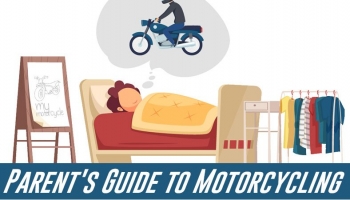Motorcycle Helmet Types and Styles – Find Out the Differences
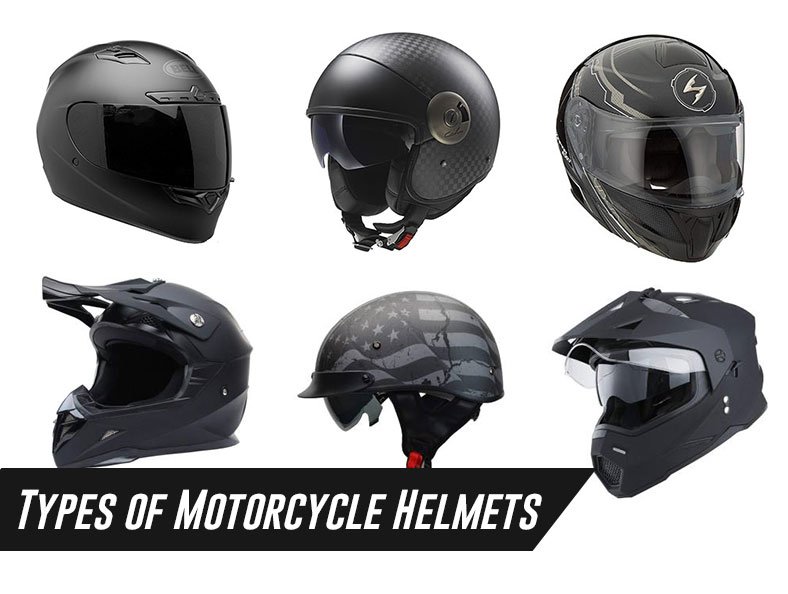
A reliable and quality helmet is an essential piece of your riding equipment. It protects your head and face in case of different accidents and impact crashes. For this reason, it has to be durable, secure and comfortable.
Nowadays, you can find several different motorcycle helmet types on the market. While they all have the same purpose, some protect you more than others.
Choosing the best is entirely up to you, but you have to know all about them in order to make the best choice. In the article below, you’ll find all the essential info on differences and similarities between the several different types.
Full-face
Full-face is probably the most popular among all the types. They cover all of your head and face, as well as your neck. In most cases, these are considered the safest type out there.
Their unique feature is the chin bar that plays a significant role in its overall safety. It’s because your chin almost always suffers severe damage during high-impact accidents. These helmets are the only ones that protect the jaw and chin area in such a way.
Most models are quite versatile and suitable for all types of motorcycles, roads, and distances. They only vary depending on the riding you do. This is why you’ll find some full-faces that are more suitable for you than others.
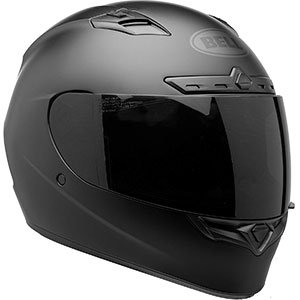
Sports riders are usually in a crouched riding position which is why they need a higher chin bar. Others like cruisers and tourers are in an upright position, so they need a lower chin bar.
One thing you’ll have to pay attention to is the ventilation system. Full-face models are completely enclosed so they’ll fog without ventilation vents.
These vents also help keep the fresh air coming in to reduce fatigue. Some even have controllable vents that you can open or close whenever you want. If you have a different temperature range where you live, you want to consider airflow ventilation as one of the most important features of your full-face helmet.
Although they’re highly protective and quite popular, the full-face style isn’t for everyone. As we said, they cover your whole face so no area is left exposed which might be difficult for claustrophobic people.
Read our versus article on modular + full face.
Modular or Flip-up
Modular or otherwise known as flip-up models are a combination of ¾ and full-face helmets. Their name comes from the design that allows the chin bar and visor to flip up.
At first glance, they look similar to full-face ones and even feature the same materials. These fit almost the same way and are entirely enclosed once the flip-up part is lowered.
Most models come with a standard visor that does an excellent job in protecting your eyes. Some may include another visor that offers better protection against sunlight.
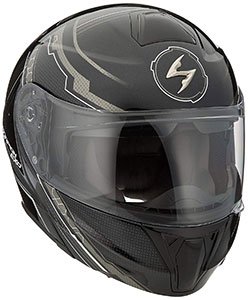
You should keep in mind that these tend to weigh a bit more. It’s the extra hinge that’s in the flip-up that adds to the overall weight. This hinge also affects overall safety because it’s a weak point during impact.
It’s an ideal model for you if you’re an adventure rider or a cruiser. It has wide eye openings, and the chin bar is lower on the face. This is excellent for an upright riding position.
A good ventilation system is equally as important to keep the air flowing once the flip-up part is lowered and covering your face. Without air vents, its visors would fog, and the inside would become quite warm.
Open-face or ¾
Open face or ¾ helmets cover the top back and sides of your head. These don’t cover your face, so you can enjoy the ride feeling the wind on your face. They’re usually used by café racers, cruisers, scooters (see top models), and tourers.
However, not only it doesn’t protect your face, but it doesn’t have a chin bar either. For this reason, it’s not considered to be among the safest.
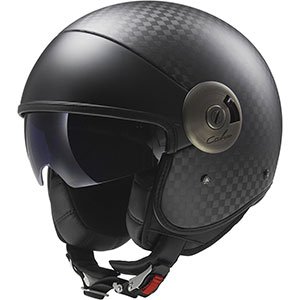
Those areas that they do cover are highly protected. In fact, they’re designed to be structurally equal to full-face models, so they do an excellent job of protecting your head.
Open-face models don’t weigh as much since they’re smaller and lack a chin bar. Keep in mind that these won’t protect you from dust, debris, and weather conditions because of the opened designed. Some might come with visors for eyes protection while others require you to buy it separately.
Due to their overall construction, these are mostly recommended to people who ride at low speeds. They’re also great for claustrophobic and people prone to fatigue.
Half Helmet
Interestingly, these are quite popular although they aren’t as protective. They cover the area from the top of your head and to your brows. For this reason, half-helmets are only able to provide minimal protection to your head.
There are a few different designs of the same type, so you might come across some that cover the back of your neck. Still, your face is exposed in all variations of this option.
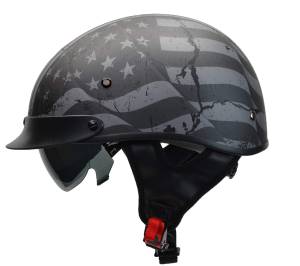
The airflow is great because the design is as open. However, they don’t protect as well as full-face or even ¾ models. Most don’t have visors or face shields so you’ll have to use goggles or other riding glasses.
Much like other opened designs, these are best for people who ride at low speeds. If you’re riding a sports bike at high speed, you probably want some more protection than what a half helmet can provide.
Off-road/Dirt Bike/Motocross
These are made specifically for off-road riding on not-so-smooth tracks and dirt roads. You shouldn’t use them in the city, and they’re not the best for highway use, but they’re great for rough areas with dust and mud.
This type has a larger visor and bigger chin bar, so it’s quite different than any other on the market. They’re designed to provide minimum weight and maximum protection. In most cases, they have effective air ventilation as well.
More Reading: 8 Top Rated Helmets for Dirt Bikes
However, motocross helmets don’t come with any eye protection, so you’ll have to use goggles. You can use other riding glasses with these, but goggles are probably the best option if you’re riding off-road. Keep in mind that some models are shaped differently in this area so double-check what eyewear will fit them.
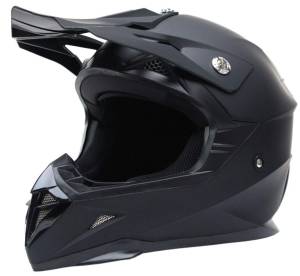
You can choose between Kevlar, fiberglass, and carbon fiber that offer strength and light weight. These materials reduce fatigue and the weight on your neck and head.
One of the best things is that you can use a neck brace or body armor with this type. In most cases, it’s best you try the two together, and at the same time, so you’re sure it all fits properly.
Off-road models are quite comfortable. A quality piece should be lightweight although they all appear a little bulky. Also, make sure the model of your choice is easy to clean if you intend to ride it on muddy and dusty roads.
Uncover more about riding dirt bikes for beginners.
Dual-sport Crossover, ADV, Enduro, Hybrid
These are considered a combination of off-road and full-face models. At first glance, their exterior looks similar to an off-road model because these also have large visors and lower chin bars. Still, their interior resembles full-face models because they’re well-padded and comfortable.
They’re designed to bring the best of both worlds, so you can use them on and off the road.
This type comes with a visor that’s often larger than the one on a full-face piece. It can also be lifted into an up position that makes it easier to wear goggles.
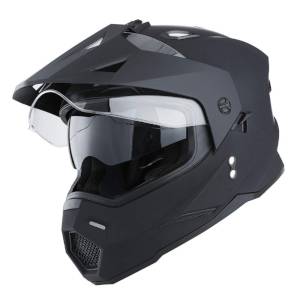
Visors are aerodynamic which means that they don’t lift in the wind. You can lower it when you’re on the street, and then raise it and use goggles for better ventilation. Their ventilation system isn’t as great, but they’re quite soundproof which means reduced road noise.
In essence, they bring the best of both worlds, but they also bring some setbacks from each type. Anyone can use them in and out of the city area as they’re quite simple and easy to put on and take off.
Racing Helmets Considerations
Track racing is an extreme sport, so you won’t be able to use your everyday half-helmet for this purpose. These have to provide safety and protection at a superior level because of how often racers fall off their bikes.
For this reason, don’t expect to find any Bluetooth speakers and other such features. These helmets are lightweight and usually feature only the necessary stuff. Any more than what you absolutely need would just put on extra weight that would slow you down.
Manufacturers opt for space-age composites to achieve the light weight. In most cases, weight is also the reason why these don’t have such great soundproofing. Still, riders always use earplugs anyway.
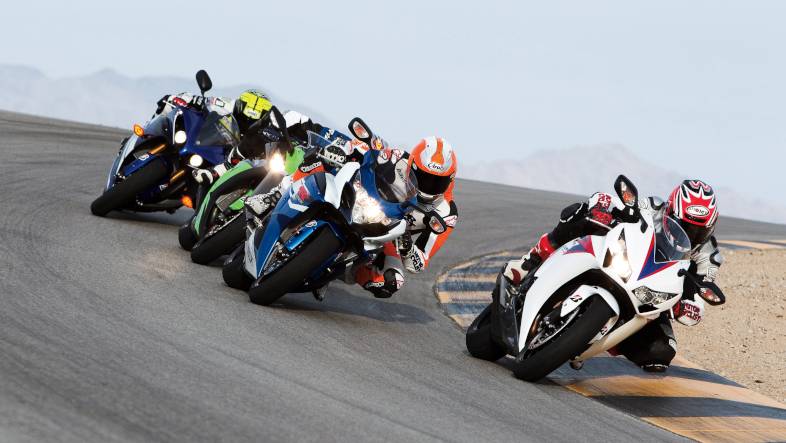
Racing helmets focus on safety, weight, and vision. Everything else is probably not included. They have wide eye ports that allow great peripheral vision. It’s an important feature because racing bikes don’t have any mirrors.
On-road models have thick face shields that are quite durable even at high speeds. In most cases, they have a locking mechanism to ensure the helmet doesn’t open during your race.
Safety is definitely the one thing these don’t lack. All models have removable padding that’s easy to take off in an emergency allowing medical personnel to remove your helmet with ease.
Furthermore, they feature Snell or ECE safety ratings, one of which may be required depending on where you race. Before you choose a particular helmet, make sure to check the criteria for the specific race entry.
Safety Standards
Regardless of the brand and type, you’re interested in; your helmet should meet at least one of the few motorcycle helmet safety standards. More so, if you live in the USA, a DOT helmet might even be law in your state.
All helmets in the USA must have this certification. Other parts of the world have their certifications, and there are even some 3rd parties offering them too. Most of these are quite similar in what they test.
Still, they differ in the way they do the tests, as well as in the values a helmet has to meet or exceed for energy distribution, retention, and impact forces.
If you want or have to wear a motorcycle helmet, make sure it has a safety certification. Some met DOT standards, while others have ECE or Snell certifications.
Typical Helmet Parts and Features
Outer Shell
The outer shell is the exterior part of the helmet you see from the outside. It’s usually made of carbon fiber, Kevlar, polycarbonate or molded plastics. It can also be a combination of those. Its function is to protect the head in the case on an abrasion or impact.
It should prevent penetration from rocks, bugs, and other outside objects. It comes in all kinds of colors, shades and design patterns.
Face Shield/Visor
This is a safety feature that helps keep all the dust, debris and bugs away from your eyes and face. These are usually removable so you can clean or replace them easier.
Some helmets come with clear visors only that’s perfect for low-light levels. Others include a few colored models as well. Different tints are available and suitable for different weather conditions and riding environments.
While you should own a clear visor as it’s the one you’ll probably use the most, a few tinted versions might also come in handy more often than not.

Impact Absorbing Liner
The inside of the outer shell usually features the EPS impact absorbing liner. Its purpose is to absorb shock and displace energy in case of an accident.
In other words, the outer shell protects your head from foreign objects, and the liner prevents that energy to transmit to your head. The better the liner, the less of those foreign objects you’ll feel landing on your head.
Liners can be different, and it all depends on the type and the particular brand. Some include a single layer of dense foam while others have a dual-density layer for better energy displacement.
Padded Comfort Layer
The liner is a safety feature, but the padded layer is there for comfort. It’s the area that supports your head while you’re wearing the helmet regardless of what type you go for.
This layer is usually made of open-cell foam and covered with a moisture-wicking material. It should be comfortable and resistant to sweat and odors. Make sure that this padding is removable and interchangeable for easier maintenance and more versatility.
Chin Strap
We’ve already mentioned how important your chin strap is. It helps secure the helmet and keep it tightly on your head as you ride.
In most cases, it’s made from a woven material with two D-rings that secure it. It’s also covered with a similar cloth that’s on the comfort padding, so it wicks away the sweat.
Your chin strap should allow only for two fingers to fit between your chin and the strap if you’ve secured it correctly.

Cheek Pads
Cheek pads aren’t featured in all the types we mentioned earlier. You’ll find them in ¾ and full-face helmets the most.
These rest against your cheeks and are removable for easier cleaning. They’re also customizable allowing you to accommodate them to the shape of your face. This comfort feature comes especially handy if you’re sharing your helmet.
The pads are similar to the padded comfort liner as they provide some additional protection and help keep the helmet in place.
Vents
The ventilation system is of vital importance for safety as well as overall comfort. They keep your head cool and help evaporate sweat and odors as much as possible.
It’s crucial for ¾ and full-face helmets, but there are no rules to what it should look like. Each brand and manufacturer has its own idea and version of a good ventilation system.
A good vent can open and close allowing you to customize the airflow depending on the weather conditions. The adjustability allows you to stay cool during summer, and keep warm during winter.
What Are Helmets Made Of?
Manufacturing has developed a lot, so there’s a wide variety of materials used. Modern helmets are very different from the first models regarding weight, safety, and looks.
The most common material is plastic, but others like fiberglass, Kevlar and carbon fiber are also available. Still, when we say plastic, it’s crucial to mention that it’s not any ordinary plastic. It’s specially engineered to meet the safety requirements.
These are the most popular because they’re the most lightweight and present a good balance between durability and weight.
Underneath the plastic shell is the thick padding foam. With these helmets, the foam padding isn’t of the best quality and usually crashes during an impact.
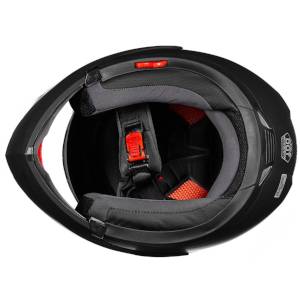
Fiberglass, on the other hand, has great flexibility. These soak up a great deal of impact and can withstand more pressure and force than plastic ones. It’s also a lightweight material, but as we said, it’s more durable and flexible than any other used in street helmets.
When it comes to high-performance racing models, you’ll come across some sturdier and extremely strong materials. In most cases, these feature Kevlar and carbon fiber in their outer shell.
These are great in absorbing the high impact that would probably break regular helmet into pieces. For this reason, Kevlar and carbon fiber models are for those who want the best safety.
When choosing a material, you should first consider the riding you do as well as the road you’re on. Finding the best one of these few materials depends on you and your personal needs and preferences.
Finding the Right Size and Shape
Whatever type you opt for, make sure you get the correct size because this plays a major role in how safe the helmet is.
The size is directly connected to comfort. For this reason, small helmets are tightly pressing on your head and might give you a headache, while big ones are noisy and plainly unsafe.
Plus, an ill fit almost always results in people giving up on wearing a helmet altogether. So, the first thing you should do is measure your head and compare the numbers with the brand’s sizing chart.
It’s probably best if you could go to an actual store to try on the specific model. If not, make sure to try the helmet the very moment it arrives, so you have enough time to replace it if you have to.
You should also consider your head shape. To help with this, some brands include replaceable interior pads that allow you to fine-tune the overall fit.
Make sure your helmet doesn’t move when your head is still. Also, it must stay in place and no slip-off while you ride. Lastly, keep in mind that it should feel a bit snug, but without any uncomfortable pressure spots.
Conclusion
Every type of a motorcycle helmet has its pros and cons, and each is designed for specific type of riders and rides. For this reason, you should build your own opinion on what’s the best type. What’s best for you might not work for someone else, while you might hate their favorite type.
Think about your bike, your average speed as well as the riding you’re doing in order to choose the best type for you. Once you do that, dedicate to finding the right fit because only if it fits will you be able to fully enjoy your helmet and what it offers.






